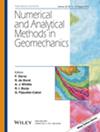包围裂纹形状对类岩石试样破坏行为的影响
IF 3.6
2区 工程技术
Q2 ENGINEERING, GEOLOGICAL
International Journal for Numerical and Analytical Methods in Geomechanics
Pub Date : 2025-06-17
DOI:10.1002/nag.4022
引用次数: 0
摘要
采用室内试验和数值模拟相结合的方法,研究了周围裂缝的形状和大小对混凝土试件压缩破坏性能的影响。检查的缺口形状各异,包括半圆形、半椭圆形、三角形、矩形、正方形和梯形,缺口与水平轴之间的夹角为45°。此外,还创建了包含15个嵌入矩形缺口的数值模型。调查的重点是不同的缺口角度(0°、30°、45°、60°和90°)和缺口长度(3、6和9 cm)。试验过程中始终保持0.01 mm/s的位移加载速率。完整试件单轴抗压强度为16 MPa,抗拉强度为1.2 MPa。不同裂隙类型的试验表明,裂隙的表面积和形状对岩体试件的断裂破坏有显著影响。建立了试样强度与裂纹扩展之间的相关性。随着节理角度的减小和裂纹面积的增大,拉伸裂纹逐渐形成,最终导致试件断裂,最终破坏。模型试件在倾角为30度时抗拉强度最低。半圆形裂纹的抗拉强度最高,矩形裂纹的抗拉强度最低。在比较实验室和数值结果时,发现岩土材料样品的破坏模式、破坏机制和强度是相似的。本文章由计算机程序翻译,如有差异,请以英文原文为准。
Effects of the Shapes of Surrounded Cracks on the Failure Behavior of Rock‐Like Samples
The research employed laboratory and numerical simulation methods to examine how the shapes and sizes of surrounding cracks influence the compressive breakage properties of concrete samples. The notches examined were of various shapes, including semicircle, semi‐ellipse, triangle, rectangle, square, and trapezoid, with an angle of 45° between the notch and the horizontal axis. Additionally, numerical models were created that included 15 embedded rectangular notches. The investigation focused on different notch angles (0°, 30°, 45°, 60°, and 90°) and notch lengths (3, 6, and 9 cm). A consistent displacement loading rate of 0.01 mm/s was maintained throughout the experiment. In the intact specimens tested, the measured uniaxial compressive strength was 16 MPa, while the tensile strength was found to be 1.2 MPa. Tests on different crack types revealed that both the surface area and shape significantly influenced the fracture and failure of rock mass specimens. A correlation was established between the strength of the specimens and crack propagation. As the angle of the joints decreased and the surface area of the cracks increased, tensile cracks developed, ultimately leading to the fracturing and final breakage of the specimens. The modeled specimens exhibited the lowest tensile strength at a 30‐degree inclination angle. Semicircular cracks displayed the highest tensile strength, whereas rectangular cracks had the lowest. In comparing the laboratory and numerical outcomes, the breakage patterns, failure mechanisms, and strengths of the geomaterial samples were found to be similar.
求助全文
通过发布文献求助,成功后即可免费获取论文全文。
去求助
来源期刊
CiteScore
6.40
自引率
12.50%
发文量
160
审稿时长
9 months
期刊介绍:
The journal welcomes manuscripts that substantially contribute to the understanding of the complex mechanical behaviour of geomaterials (soils, rocks, concrete, ice, snow, and powders), through innovative experimental techniques, and/or through the development of novel numerical or hybrid experimental/numerical modelling concepts in geomechanics. Topics of interest include instabilities and localization, interface and surface phenomena, fracture and failure, multi-physics and other time-dependent phenomena, micromechanics and multi-scale methods, and inverse analysis and stochastic methods. Papers related to energy and environmental issues are particularly welcome. The illustration of the proposed methods and techniques to engineering problems is encouraged. However, manuscripts dealing with applications of existing methods, or proposing incremental improvements to existing methods – in particular marginal extensions of existing analytical solutions or numerical methods – will not be considered for review.

 求助内容:
求助内容: 应助结果提醒方式:
应助结果提醒方式:


